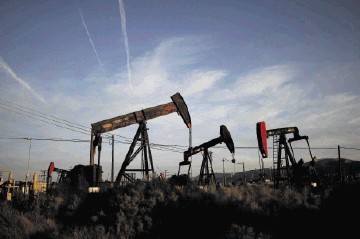
Crude’s advance of more than 90% from a 12-year low earlier this year has US shale producers starting to return to their drilling rigs, threatening to slow further gains.
“The $50-to-$60 a barrel area is the sweet spot,” said Mark Watkins, the Park City, Utah-based regional investment manager for The Private Client Group of U.S. Bank, which oversees $128 billion of assets. “You start to have producers come back at $50, but a lot of them come in at $60.”
Money managers were cautious in the week ended June 7, betting more heavily on a price drop than on further gains, according to data from the Commodity Futures Trading Commission. West Texas Intermediate rose 2.6 percent to $50.36 a barrel on the New York Mercantile Exchange during the report week and fell 48 cents, or 1 percent, to $48.59 at 12:14 p.m. London time on Monday.
Prices have climbed enough for Continental Resources to dispatch fracking crews to unfinished wells in the Bakken shale region, chief executive Harold Hamm said earlier this month.
Those wells were left uncompleted as tumbling prices forced explorers to halt projects to conserve shrinking cash flows. Helmerich & Payne Inc., the biggest drilling-rig contractor in the US, and Independence Contract Drilling said last week they were receiving more queries from oil explorers.
“Everyone is questioning the price when US rigs come back,” Paul Sankey, an energy analyst at Wolfe Research LLC, said June 10 on Bloomberg Radio. “At $55 to $60 we would return to growth in the US.”
The number of active oil rigs in the US increased by three last week after jumping by nine in the prior seven days, the first back-to-back gain since August, Baker Hughes data show. US crude production is still well below last year’s peak, and explorers have idled more than 1,000 oil rigs since the start of last year.
Forecasters including the International Energy Agency and Goldman Sachs agree the crude glut is starting to dwindle as OPEC’s policy of maintaining output squeezes out higher-cost rivals.
Outages also have taken their toll on supply, with global disruptions reaching an average 3.6 million barrels a day last month, the most since the Energy Information Administration began tracking them in 2011.
Fires that began early May in Alberta took out an average 800,000 barrels of Canadian supply last month, while Nigerian crude output dropped to the lowest in 27 years as militants increased attacks on pipelines in the Niger River delta.
“In April and May, before the worst of the disruptions, there was already a consensus that the market would be in balance the second half of the year,” said Michael Wittner, the New York-based head of oil-market research at Societe Generale. “Nigeria and Canada just accelerated the rebalancing.”
Hedge funds’ short position in WTI rose by 24,324 futures and options combined to 77,701, the biggest percentage gain in 11 months, CFTC data show. Longs, or bets on rising prices, increased by 17,065, reducing the net-long position by 3 percent.
In the Brent market, money managers raised bullish bets by 5,326 contracts in the week, according to data from ICE Futures Europe. Bets that prices will rise outnumbered short positions by 389,251 lots, the London-based exchange said in a report.
In other markets, net bullish wagers on U.S. ultra low sulfur diesel dropped 8.8 percent to 14,115 contracts as futures climbed 2.9 percent. Net bullish bets on Nymex gasoline slipped 22% to 12,552 contracts, the lowest since November. Gasoline futures decreased 1.7 percent in the period.
The oil rally is setting up the conditions of its own demise, according to Watkins and Sankey. When the rigs return to the shale patch, prices will move lower.
“This is the most hated bull market in history,” Sankey said. “Everyone thinks it will end.”